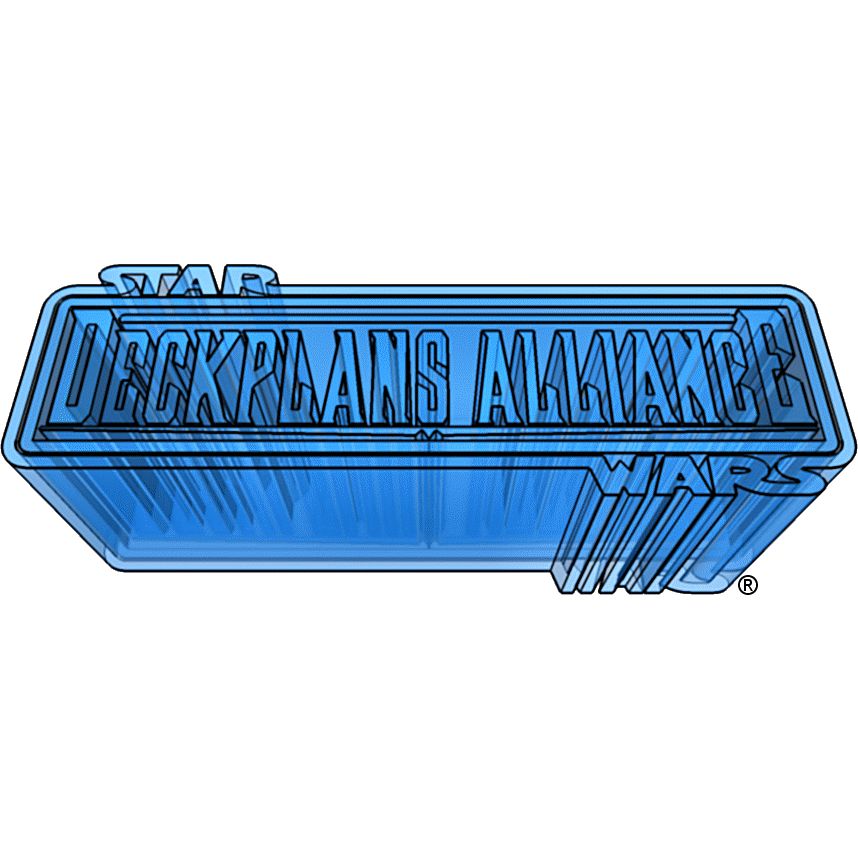

A joint-effort project developed by Frank V Bonura, “B.M.K”, and Sean Callahan. The deckplan, and exterior views are based mainly on the original drawing of the Ghtroc Class 720 from the "STAR WARS The Roleplaying Game" Second Edition (page 121), drawn by John Paul Lona. Likewise, the project was also inspired by the original Cargo Empress deckplan from the "STAR WARS Adventure Journal" #9 (p. 69), drawn by Matt Busch.
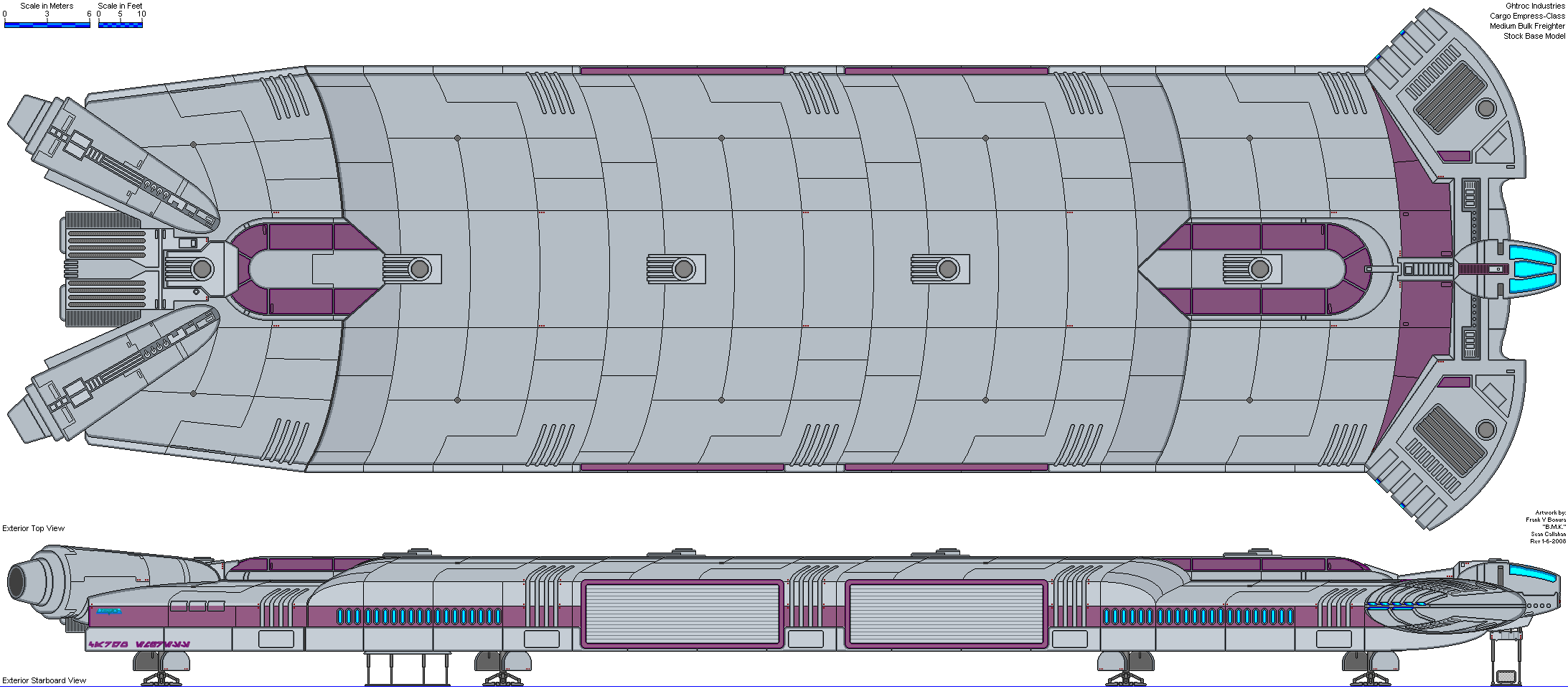
Capsule: After the release of the Ghtroc 720, and its relative success, Ghtroc Industries tried to parlay their toe hold in the market into a foothold with the Cargo Empress-class "super-freighter". The attempt failed and contributed to Ghtroc's eventual bankruptcy.a Most of the Empresses were dumped on the market at low prices, to help pay Ghtroc's debts, so they were quickly snapped up and are currently fairly widespread, if not common.
— “Star Wars® - Pirates & Privateers”, p. 68
Ghtroc Industries Cargo Empress Freighter
— “Star Wars® - Pirates & Privateers”, p. 68
- Craft: Ghtroc Industries Empress-class Super Freighter
- Type: Medium Bulk freighter
- Scale: Starfighter
- Length: 110 meters
- Crew Skill: Space transports: Cargo Empress freighter
- Crew: 4
- Passengers: 8
- Cargo capacity: 50,000 metric tons
- Consumables: 2 months
- Cost: 1,000,000 (new), 825,000 (used)
- Hyperdrive Multiplier: x2
- Hyperdrive Backup: None
- Nav Computer: Yes
- Maneuverability: 0D
- Space: 2
- Atmosphere: 225; 650 km/h
- Hull: 3D+2
- Shields: 1D
- Sensors:
- Passive: 15/0D
- Scan: 30/1D
- Search: 40/2D
- Focus: 2/2D
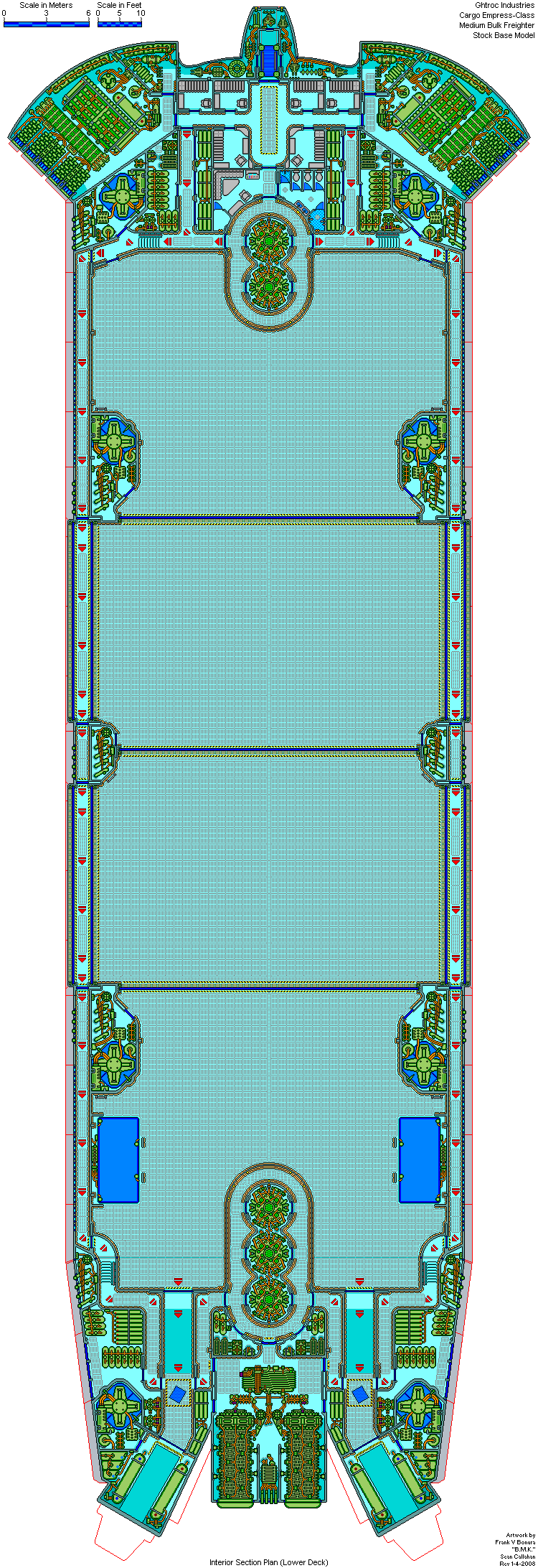
The lower deck is a complete deck with up to 5.74 meters (18ft 8in) of headroom. In some areas, the ceilings on this deck have various pull-down hatches equipped with fold-down ladders for accent, to facilitate system repairs, maintenance, and replacement of fuel cells (for specific locations consult upper deck). Grill works on this deck are removable allowing access to the ship's massive repulsorlift systems and for repair and maintenance of any systems below deck. The lower deck is comprised of three regions:
These regions are situated at different elevations. Descriptions of the various regions are listed, and described below.
This region of the ship has up to 2.29 meters (7ft 6in) headroom, and is at a higher elevation than the expansion module. Descent via stairs is required to access the Expansion Module Compartments. Descriptions of the various compartments are listed, and described below.
The "chin" houses the ship's entry lift (rated at 500 kg) and forward airlock. This airlock is fully functional and can be used for space walks.
The outer "chin", "shoulders" and "epaulets" contain the ships sensors and communication equipment. This equipment can be accessed and serviced through access doors in the entry lift room.
The forward "fins" house the ships ion maneuvering thrusters, forward/flanking shields (projectors, Controllers, and generators), and the ship's batteries. Also housed here are some of the ship's consumable storage tanks, fuel tanks, and fueling pumps. All can be accessed for service or maintenance by the doors at the ends of the forward corridors.
Behind the forward "fins" is an area affectionately called the "armpit." These two rooms (port: room 1 & Starboard: room 2) house equipment for landing struts 1, and 2. Also housed here are the booster coils for the ship's hyperdrive. These rooms can be accessed from their respective escape corridors. A skillful pilot could shoot here and cripple the ship's hyperdrive with minimal damage to the rest of the ship.
Behind the sensor compartment ("shoulders") of the ship are a line of rooms. They contain the four passenger berths (bedrooms), and the central foyer.
The passenger berths (bedrooms) contain 2 beds, a dresser, and 1 padded chair each. The room locations provide the least noise and vibration for passengers comfort.
Located aft of the entry lift. A ramp to the upper deck lowers from the ceiling in this room to provide access to the cockpit above.
Located port and starboard of the foyer. Adjacent to, and aft of the passenger berths. They provide access to the escape corridors and all berths (bedrooms) on board.
The crew berths (bedrooms) contain 2 beds, 2 dressers, 1 padded chair, and 1 small wall-mounted desk each. Noise and vibration in these rooms are almost as good as the passenger berths.
Located aft of the crew berths are the galley (kitchen- port side), and head (bathroom - starboard side). Both galley and head are designed to deal with 4 crew and 8 passengers as long as all donít try to eat, bathe, wash, and go to the toilet at the same time. The head has 2 sinks, 3 toilets, 1 single and 1 double shower. The galley has 1 food processor, seating for 8, 1 refrigerator and 1 pantry.
The oval-shaped corridor provides a barrier of protection for the ship's power cores #1, and #2 from cargo loading activities in cargo hold 1. From this compartment, power cores #1 and #2 can be accessed at its center, and allows access forward to the ship's galley, and the escape corridors.
Behind the Galley & Head, are the forward bank of power cores #1, and #2. Two of the ship's five reactors. The cores extend to the upper deck and are surrounded by the forward ring corridor.
Adjacent to, and accessed by the escape corridors, these compartments house some of the ships life support equipment.
Adjacent to, and accessed by the escape corridors, these compartments house some of the ships fuel cells.
This region of the ship has up to 18.8' (5.74m) of headroom, and rests at a lower deck elevation than the rest of the ship. Ascent via stairs is required to access the decks of adjacent regions of the ship. The vaulted ceiling of this region extends upward to the upper deck forming one giant cavity for cargo storage. Descriptions of the various compartments are listed, and described below.
Oriented from front to back, hold 1 is located towards the bow, and hold 4 is located towards the aft. Designed to hold dozens of cargo pallets, speeders, swoops, many truck-sized ground vehicles, or even several starfighters, the cargo holds are separated by three giant rolling doors that retract into the deck. These huge doors are further protected by magnetic shields that allow the passage of solid objects, but retain the ship's atmosphere. These holds can be accessed from various points along the ship's escape corridors.
Located at the fore most point of the expansion module, hold 1 houses booster and strut compartments 3 (port), and 4 (starboard). This massive compartment is accessed via the two doors forward to the escape corridors, or from the giant shielded cargo door aft.
Located aft of hold 1, this huge compartment houses landing bay doors 1 (port), and 2 (starboard). The landing bay doors are double doors allowing airlock functions for the ship. Both doors have magnetic shields allowing shuttles, escape pods, and fighters, to enter and exit the ship without venting the ship's atmosphere. This compartment can be accessed from any direction via the giant shielded doors. The landing bay doors are 44'-8"(13.62m) wide, and 13'-6"(4.12m) high, and allow access by all vessels, vehicles, and cargos smaller than these dimensions.
Located aft of hold 2, this huge compartment houses landing bay doors 3 (port), and 4 (starboard). The landing bay doors are double doors allowing airlock functions for the ship. Both doors have magnetic shields allowing shuttles, escape pods, and fighters, to enter and exit the ship without venting the ship's atmosphere. This compartment can be accessed from any direction via the giant shielded doors. The landing bay doors are 44'-8"(13.62m) wide, and 13'-6"(4.12m) high, and allow access by all vessels, vehicles, and cargos smaller than these dimensions.
Located at the aft most point of the expansion module, hold 4 houses two cargo lifts for ground loading. These lifts are rated at 3 metric tons each. Access to this compartment can be gained via the shielded door forward, and the two ramp doors aft ward.
These compartments are Similar to the forward landing gear rooms 1 & 2, containing equipment for landing struts 3, 4, 5, and 6. These rooms also house the booster coils for the ship's hyperdrive. These rooms are located in cargo holds 1, and 4,and between 2 and 3, along the outer secondary bulkheads (#3, #5, #7 port, #4, #6, #8 starboard). These compartments possess many interchangeable parts if the need arises. They can be accessed for service and maintenance from the cargo holds. A skillful pilot could shoot here and cripple the ship's hyperdrive with minimal damage to the rest of the ship.
This region of the ship has up to 2.29 meters (7ft 6in) headroom, and is at a higher elevation than the expansion module. Descent via ramp or stairs is required to enter the Expansion module Compartments. Descriptions of the various compartments are listed, and described below.
The oval-shaped corridor provides a barrier of protection for the ships power cores #3, #4, and #5, from cargo loading activities in cargo hold #4. From this compartment, power cores #3, #4, and #5 can be accessed at its center, and allows access aft to the ship's main engine room, access to the aft life support rooms, and the escape corridors.
Forward of the main engine room, are the aft bank of power cores #3, #4, and #5. Three of the ship's five reactors. The cores extend to the upper deck and are surrounded by the aft ring corridor.
Adjacent to, and accessed by the ring corridor, these compartments house some of the ships life support equipment.
Adjacent to, and accessed by the escape corridors, these compartments house some of the ships fuel cells, and consumables.
Located behind the aft fuel rooms next to the escape corridors. Similar to the forward landing gear rooms with many interchangeable parts if the need arises. They can be accessed for service and maintenance by doors in the aft loading compartments.
Located at the very aft of the ship in the "rear legs". Ramps from the above deck provide access to the upper docking rings and allow freight to be slid down additional corridors and ramps to the cargo holds. When raised, these ramps form the launch track for the escape pods above. These rooms also house various mechanicals and consumables tanks that are critical to ship and escape pod operation.
Just outside of each loading room, caution stripes on the floor indicate [NO LOAD] areas to allow passengers and crew access to the escape pods. The escape pods are accessed from pull-down hatches in the ceiling equipped with fold-down ladders for accent into the pod. A loading lift is also located in this area for use with droids, or other passengers who can not climb a ladder. The escape lift is marked with caution stripes, and can lift 1 metric ton in 2 seconds to the escape pod if the emergency mode is used.
Located behind the aft reactor room at the very aft of the ships "tail". This compartment houses from fore to aft: hyperdrive, 2 ion drives, 2 thrusters, and aft hyperdrive booster module.
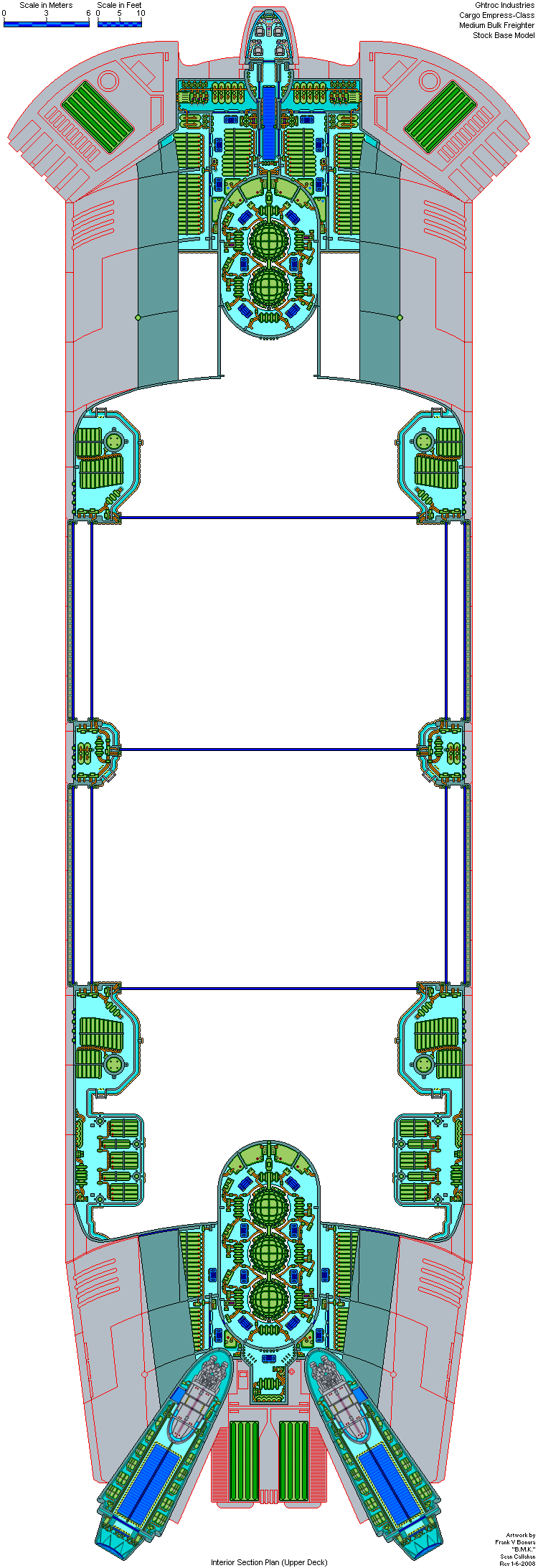
Unless otherwise noted, this deck has a maximum ceiling height of 2.29 meters (7ft 6in) headroom in the cockpit, magnetic shielding rooms, and docking arms. The rest of the upper deck is mostly crawlspaces with little more than 90cm (3ft) of headroom. Comprising the bulk of the Empress' upper deck, are stores for most of the ship's fuel and consumables. The upper deck is comprised of three regions:
These regions are situated at different elevations. Descriptions of the various regions are listed, and described below.
This region of the ship has up to 2.29 meters (7ft 6in) headroom in the cockpit, and is at a higher elevation than the expansion module. There is also no access to the expansion module from this region of the upper deck. Descriptions of the various compartments are listed, and described below.
Located in the "head". The cockpit is equipped with 4 control stations. The 2 forward control stations can perform all ship functions; the 2 aft control stations can control: life support, docking, loading, shields, sensors, communication systems, and power core energy management. The 2 aft control stations must be manned during normal ship operations due to the added management needs of the ship's 5 linked power cores.
Located behind the cockpit to either side of the ramp compartment, these curved rooms can be used for storage or spacesuits. They also house the ship's avionics systems. If you are wondering why these rooms seem so empty, its because they were designed for upgrades to weapon and avionic controls.
Located aft of the cockpit in the "neck". This ramp is fully sealed preventing depressurization between decks. This upper ramp lowers to provide access to and from the central foyer in the deck below. This ramp allows astromech droids access to the cockpit. In the aft end of this compartment are the ship's main wiring trunks, the ramp control motor, and hydraulic pump.
Located in the "shoulders" to either side of the cockpit. These compartments hold some of the ship's life support equipment and atmosphere recyclers. Some life support consumables are stored here as well.
Located to either side of the ramp compartment. These rooms house some of the ship's electrical system controls fuel cells, fuel pumps, and consumables storage tanks. These rooms can be accessed from the ramp compartment or service panels in the floor. The power couplings that power the weapons on the Class 720 Light Freighter are not used on this unarmed model, but can be plugged into for weapons upgrades. A special adapter would be needed to install larger capital scale weapon systems, even though the ship has sufficient power to charge one. Weapon charging systems on the port side have sister systems on the starboard side, also unused on this model. These couplings can be used for additional weapon upgrades that require more power.
Located in the aft center of this region in the forward domed "Spine". This compartment partially extends to the deck below. It houses the ship's upper power cores: #1, #2, and power converters. This compartment can be accessed from 6 service panels in the floor.
Located above "Booster and Strut Compartments 1 & 2". These compartments contain some of the ship's fuel cells, and some life support equipment. These rooms can be accessed from the forward fuel compartments or service panels on the ceiling of the deck below.
This region of the ship has up to 2.29 meters (7ft 6in) headroom, and rests at a lower elevation than other regions of the upper deck. Descent via ladders is required to access the deck below. Adjacent regions of the ship are not accessible from this area. The vaulted chamber extends down to the lower deck. Areas in this region are open to the cargo holds adjacent to them. These areas are protected by meter high guardrails, providing an excellent view of the cargo holds on the deck below. Descriptions of the various areas are listed, and described below.
These areas are located in cargo hold #1, sitting atop "Booster and Strut Compartments" #3, and #4. Located here is access for 2 of the ship's main shield generators (Not shown along catwalk by ladder). Stored on this platform are stores of fuel, the upper mountings of landing struts #3, and #4, as well as the magnetic shielding equipment for the cargo doors and external bay doors of the ship.
These areas are located between in cargo holds #1 and #2, sitting atop "Booster and Strut Compartments" #5, and #6. Stored on this platform are stores of atmosphere consumables, and some of the magnetic shielding equipment for the cargo doors and external bay doors of the ship.
These areas are located in cargo hold #4, sitting atop "Booster and Strut Compartments" #7, and #8. Located here is access for platforms #7, and #8 (catwalk). Stored on this platform are stores of fuel, the upper mountings of landing struts #5, and #6, as well as the magnetic shielding equipment for the cargo doors and external bay doors of the ship.
These areas are located in cargo hold #4, sitting atop the cargo lifts. Stored on this platform are stores of fuel, 2 of the ship's main shield generators with support equipment (one each per side).
This region of the ship has up to 2.29 meters (7ft 6in) headroom, in the docking arms, but is otherwise not much more than crawlspaces of 3' (90 cm) in height. The region is also at a higher elevation than the adjacent expansion module. There is no access from this region to the Expansion module on the upper deck. Descriptions of the various compartments are listed, and described below.
Located in the forward center of this region in the aft domed "Spine". This compartment partially extends to the deck below. It houses the ship's upper power cores: #3, #4, #5 and power converters. This compartment can be accessed from 8 service panels in the floor.
Located to either side of the upper reactor room, these compartments house some additional consumables, fuel and electrical controls for the ship. These compartments can be accessed from 4 service panels in the floor (2 on each side).
Located directly aft of the upper reactor room. This room houses the aft shield projectors, shield Controllers, and shield generators. This compartment can be accessed from a single service panel in the floor.
Located at the very aft of the ship in the "Rear legs". These docking arms serve several functions: airlock, docking ring, and escape pod launcher. The decks of the docking arms form a ramp when lowered to allow freight to be moved to and from the cargo holds in the lower deck. The ramps when raised serve as launch tracks for the escape pods loaded in the docking arms. For complete details of the Class 700 Escape Pod used on the Ghtroc 720 please consult its respective entry on this website. The Docking arms are triple sealed and are suitable for space walks for exterior repairs. The docking rings are designed for universal magnetic seal coupling and will dock with any standard airlock for ship to ship docking and transfer. The escape pods are accessed from the lower deck via a pull-down hatch in the ceiling.
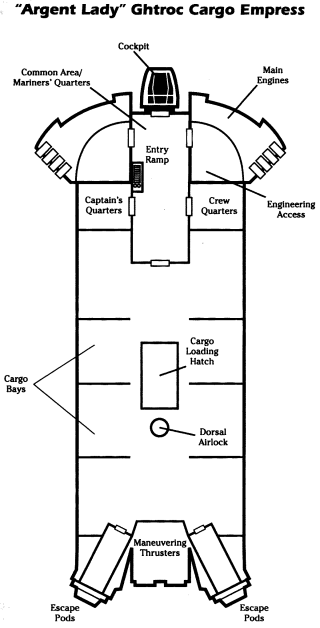
After studying the stats and images in “Star Wars® - Pirates & Privateers” (pages 59 and 68), and the "STAR WARS Adventure Journal" #9 (pages 68-69), we discovered the Empress-class was nothing more than a Ghtroc 720 that had been extended like a super-stretch Limousine. Keeping this in mind, we attempted to keep the front section and back section of the ship as similar to the Class 720 to save on production costs, just as Ghtroc Industries would have. We also developed larger landing gear to bear the weight of the extended center section of the ship. In tradition with the Class 720 Light Freighter we also noticed the Cargo Empress looked similar to a marine animal, in this case a manatee so we decided to refer to parts of the ship in terms of a manatee's body. Thus the following structures were assigned body part names to assist in describing the various structures during construction:
Note: We make reference to all these part names on this deckplan page as well as other ships based on it.
The ship has been divided into 3 sections for purposes of describing it:
For additional information regarding the original ship the Cargo Empress was based on, consult the Class 720 Light Freighter page on this site.